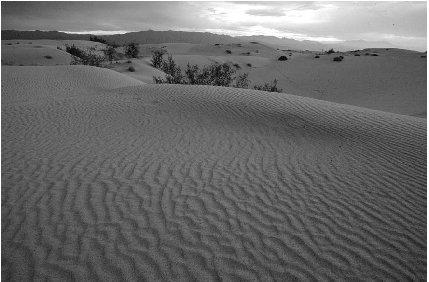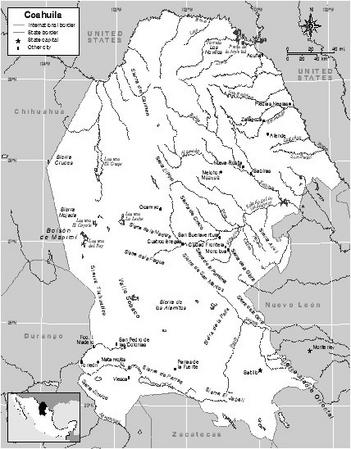Coahuila

Pronunciation: koh-ah-WEE-lah.
Origin of state name: The natives living in the territory were the Coahuilas. The Spaniards named them Coahuiltecos and called the territory New Extremadura. They later renamed it Coahuila .
Capital: Saltillo.
Entered country: 1917.
Coat of Arms: The lower section depicts walnut trees growing near the Monclova River, seen at sunrise to depict the state rising up after the Mexican Revolution . The Spanish town known as San Francisco de Coahuila (later renamed Monclova) was founded on the banks of the river; it was the capital of Coahuila for many years. In the left panel an oak tree and two wolves represent Biscay, the home province of many of the Spanish settlers. The right panel features a lion and a column, with a banner bearing the words Plus Ultra (Higher).
Holidays: Año Nuevo (New Year's Day—January 1); Día de la Constitución (Constitution Day—February 5); Benito Juárez's birthday (March 21); Primero de Mayo (Labor Day—May 1); Revolution Day, 1910 (November 20); and Navidad (Christmas—December 25).
Flag: There is no official flag.
Time: 6 AM = noon Greenwich Mean Time (GMT).
1 Location and Size
Coahuila, in northern Mexico, is one of the three largest states in Mexico. It has an area of 149,511 square kilometers (57,726 square miles), about the same size as the US state of Michigan. Coahuila is bordered on the north by the US state of Texas; on the east by the Mexican state of Nuevo León; on the south by the Mexican states of Zacatecas, Durango, and San Luis Potosí; and on the west by the Mexican state of Chihuahua. Coahuila has thirty-eight municipalities. Its capital is Saltillo.
The state is crossed from north to south by the Sierra Madre Oriental mountain range. ( Sierra means mountains in Spanish.) Its mountains include the Sierra El Pino, Sierra Mojada, Melchor Ocampo, Los Novillos, Corazón del Toro, El Tunal, and El Jabalí.
Coahuila also has desert plains with sand dunes. The Bolsón de Mapimí desert is an enormous desert region. The fertile Comarca Lagunera lies in the southeast.

Bilbao dunes.
The most important rivers are the Bravo, Sabinas, San Rodrigo, San Diego, Santa Rosa, Castaños, Boquillas, and Canastas Rivers. The Nazas and Aguanaval Rivers have been dammed.
A large part of its territory is made up by the Bolsón de Mapimí, an enormous desert region characterized by little rain and scant vegetation.
2 Climate
Temperatures average 12° C (53° F ) in January and 23° C (73° F ) in June and July. Annual rainfall averages 610 millimeters (24 inches), much of which falls during September and October.
3 Plants and Animals
The native plants include species of pine trees and walnut trees. The fibers of the ixtle plant (a type of cactus) are used for handicrafts.
Tortoises nest in the coastal areas, and the waters are filled with all kinds of marine life. Animal life ranges from bears to prairie dogs, wild boars, wolves, raccoons, deer, and berrendos (which resemble deer). Bird species include dwarf parrots and eagles. The hot, dry desert supports rattlesnakes as well.
4 Environmental Protection
As one of the states that borders the

5 Population, Ethnic Groups, Languages
Coahuila had a total population of 2,298,070 in 2000; of the total, 1,140,195 were men and 1,157,875 were women. The population density was 15 people per square kilometer (39 people per square mile). In 2000, the capital, Saltillo, had a population of 577,352. Almost all residents speak Spanish. A small percentage (0.2%) speak one of the Amerindian languages.
6 Religions
According to the 2000 census, 76% of the population, or 1.7 million people, were Roman Catholic; 6%, or 137,388 people, were Protestant. That year there were also 1,862 Seventh-Day Adventists, 8,108 Mormons, 25,370 Jehovah's Witnesses, and nearly 100,000 people who reported no religion.
7 Transportation
Three major highways connect the cities within Coahuila and connect Coahuila to its neighboring states. The capital, Saltillo, is linked by railroad to other major cities in the state, as well as to Monterrey in Nuevo León, Nuevo Laredo in Tamaulipas, and Mexico City.
There are two airports: Ramos Arizpe airport is 15 minutes away from Saltillo. Plan de Guadalupe International Airport, also near Saltillo, provides air service to Mexico City and to the Texas cities of Dallas, Forth Worth, and Houston.
8 History
When the Spaniards arrived in the mid-1500s, Coahuila was mostly inhabited by groups of hunters and gatherers. In the Lagunera Comarca region, indigenous people had constructed villages. They practiced rudimentary agriculture and fishing.
The Spaniards settled in the region in the late 16th century, when the city of Santiago del Saltillo del Ojo del Agua was founded. The Spaniards brought native people from neighboring Zacatecas to promote settlements, since the natives of Coahuila tended to migrate while hunting animals and gathering food. The conquest of territories by the Spaniards progressed slowly throughout the 17th century. In 1675, Saltillo mayor Antonio Balcárcel Rivadeneyra led an expedition that took control of the Río Grande River and ventured into what is now Texas.
When independence was declared in central Mexico in 1810, Coahuila mostly ignored the conflict between royalists (people loyal to Spain) and patriots (people interested in independence for Mexico). Landowners were more concerned with fighting indigenous revolts and transforming the precarious economy into a productive agricultural region. In 1811 , Mariano Jiménez led troops in a movement to promote and consolidate independence in northern Mexico (including Texas). The failure of this effort caused Coahuila to remain under royalist control until 1821. That year the Plan of Iguala allowed for the consolidation of an independent Mexico.
When it declared independence in 1835, Texas was a territory under the jurisdiction of Coahuila. When the Mexican-American War (1846–48) broke out after Texas was annexed to the United States, leading the Mexicans was general and politician Antonio López de Santa Anna (1794–1876). Santa Anna abandoned the patriots of Saltillo, Coahuila, and they were left alone to resist US occupying forces. US troops occupied Saltillo until the war was over and the Guadalupe Hidalgo treaty was signed in 1848. In the treaty, Coahuila ceded all its territories north of the Río Grande. Although some leaders in Coahuila had expressed their intent to join Texas as part of the United States, most preferred to remain a part of Mexico.
Coahuila leader Francisco Madero (1873 – 1913) published Presidential Succession, a book that eventually launched his presidential candidacy in 1910. Some people believed that Porfirio Díaz (1830–1915), who had been leading the country as a dictator since 1876, should be replaced. Madero, angry about Díaz's rule, called for a revolution on November 20, 1910. Madero was elected president in 1911 but was assassinated two years later. His ally, Venustiano Carranza (1859–1920), successfully took control of Mexico and declared victory in the revolution. After a new constitution took effect in 1917, Carranza's national reputation grew. He became the first elected president of Mexico after the revolution.
Since it was the home state of two of the most important leaders of the Mexican Revolution (Madero and Carranza), Coahuila occupies an important role in Mexican history. It is also one of the key states where the dominant political party in Mexican politics, the Institutional Revolutionary Party (PRI), developed and grew.
9 State and Local Government
The constitution dates from 1818, but reforms were adopted in 1951. Since then, the executive power has been vested in a governor, elected democratically every six years for a nonrenewable term. The legislature is comprised of a thirty-five-member Chamber of Deputies. Twenty of the deputies are elected in single member districts and the remaining fifteen by proportional representation. Deputies are elected for nonrenewable three-year terms. The formal separation of powers and check and balances provisions have been undermined by the excessive concentration of power on the hands of the PRI since the end of the revolution.
There are thirty-eight municipalities. Municipal governments are relatively weak, as the state government continues to exercise enormous influence over local authorities. Municipal presidents and councilors are elected for three-year terms and immediate reelection is not allowed.
10 Political Parties
The three main political parties in all of Mexico are the Institutional Revolutionary Party (PRI), the National Action Party (PAN), and Party of the Democratic Revolution (PRD).
The PRI has exercised absolute control in Coahuila. The twenty-six governors who have occupied the office since revolutionary leader Venustiano Carranza abandoned the governorship to become president of Mexico have all belonged to the PRI. PRI candidate Enrique Martínez y Martínez was elected in 1999, reflecting the electoral strength of the party that ruled Mexico since 1917.

Traditional striped fabric of the serape.
11 Judicial System
The judiciary is independent in theory. Historically the judicial system has been under the control of the state governor. The Superior Tribunal of Justice is comprised of seven members appointed for nonrenewable six-year terms by the governor, with legislature approval. Only qualified attorneys can be appointed. The Tribunal president is elected for a three-year term and can be reelected once. There is also an electoral tribunal. Local courts complete the state's judicial system.
12 Economy
Mining, agriculture, and manufacturing are all important to the economy. The state produces over one-third of Mexico's steel, which supplies manufacturing facilities operated by US automakers General Motors and DaimlerChrylser. As one of the states that borders the United States, Coahuila has many processing plants, known as maquiladoras. The number and size of these plants grew rapidly after the North American Free Trade Agreement (NAFTA), a trade agreement between Mexico, the United States, and Canada, was enacted.
Among the agricultural products produced in Coahuila are cotton and various food crops, including dairy products.
13 Industry
Much of the state's industry relates to the manufacture of automobiles, an industry that has developed since 1992 when the North American Free Trade Agreement (NAFTA) was signed. There are stamping plants, engine production plants, and vehicle assembly plants. There were about two hundred maquiladoras (assembly plants) employing about 100,000 workers in 2003.
14 Labor
The US Bureau of Labor Statistics reported that Mexican workers saw their wages increase 17%, from $2.09 per hour in 1999 to $2.46 per hour in 2000. Wages for workers in Coahuila are slightly below (about 90%) the national average. (The average US worker earned $19.86 per hour in 2000.) After one year, workers are entitled by law to six days paid vacation.
15 Agriculture
Agriculture is an important segment of the economy. Cotton, potatoes, grapes, watermelons, apples, alfalfa, wheat, oats, corn, sorghum, cotton, and nuts are among the state's agricultural crops. Several dams have been built to create reservoirs that can be used for irrigation.
Dairy cattle are raised to supply the state's milk-processing plants.
16 Natural Resources
Mining is an important part of the economy. Although coal accounts for only 4% of Mexico's total energy requirements, the majority of the country's coal reserves are located in Coahuila.
Other minerals mined in Coahuila include iron, titanium, feldspar, lead, and dolomite.
17 Energy and Power
Coal-fired plants supply a relatively small percentage of the country's electricity, but the Federal Electricity Commission (CFE) approves the use of coal to fuel power plants near the Coahuila mines. Coal is being replaced by natural gas in most power plants, since burning Mexican coal produces a high amount of ash and causes air pollution.
18 Health
Coahuila has 38 general hospitals, 334 outpatient centers, and 93 surgical centers.
Most of the Mexican population is covered under a government health plan. The IMSS (Instituto Mexicano de Seguro Social) covers the general population. The ISSSTE (Instituto de Seguridad y Servicios Sociales de Trabajadores del Estado) covers state workers.
19 Housing
Most of the state's housing is adequate. Only 5% of housing is in need of replacement or significant upgrading.
20 Education
The system of public education was first started by President Benito Juárez (1806–1872) in 1867. Public education in Mexico is free for students from ages six to sixteen. Many students elect to go to private schools. There were nearly 500,000 school-age children in Coahuila in 2000.
The thirty-one states of Mexico all have at least one state university. The Universidad Autónoma de Coahuila (Independent University of Coahuila) is in Saltillo.
21 Arts
Coahuila has a dance group, DanzArte. The state is also famous for the serape (wool cape), and many artisans open their studios for people to watch the making of serapes and to purchase serapes. Coahuila is also noted for works made from wrought iron. There are many theaters and auditoriums featuring dance and music.
22 Libraries and Museums
Coahuila has 113 branches of the national library. There are twenty-nine museums. The capital, Saltillo, has a museum of science and technology and a bird museum. Torreón has a railroad museum and a museum of paleontology (fossils). Cepeda has a museum on the history of Mexican revolutionary and president Benito Juárez.
23 Media
The capital city, Saltillo, has two papers: Palabra and Vanguardia. The city of Piedras Negras has Zócalo, and the city of Torreón has four papers: El Siglo de Torreón, La Opinión, Noticias de El Sol, and La Laguna. There is both conventional and wireless telephone service available in the area around the capital, Saltillo.
24 Tourism, Travel, and Recreation
Saltillo is a popular tourist destination. The city is sometimes called "Athens of Mexico" because of its rich culture. It is also the "city of the serape" (the famous draping scarf worn by Mexican men and women).
Many buildings in Saltillo are constructed of pink quarry and limestone. Zaragoza Park is a large park in the city. The state fair is held in late July and early August each year in Saltillo. Monclova has the Devil's Cave, which has ancient cave paintings. Also in Monclava, an industrial city, the Feria de Acero (Steel Industry Fair) is held the second week of July each year.
25 Sports
Saltillo, the capital, hosts the basketball team Lobos. Saltillo's professional baseball team, Los Saraperos de Saltillo, plays in the Parque Francisco I. Madero, which seats 14,000.
Torreón's basketball team, Los Algodoneros de la Comarca, plays in the Municipal Stadium, which seats 2,500. Torreón's soccer team, the Santos Laguna, plays in the Corona stadium, which holds 25,500 people. Torreón also has a minor league baseball team, Los Algondoneros de la Unión Laguna, which plays in the Estdio de la Revolución holding 8, 500 people. Torreón also has a Plaza de Toros (bullfighting ring) that seats 10,000 people.
Monclova's baseball team, Los Acereros del Norte, plays in the Estadio Monclova, which holds 9,000 spectators.
26 Famous People
Francisco Indalécio Madero (1873–1913) was called the Father of the Revolution for working to overthrow the dictator Porfirio Díaz. Madero was born in Parras, Coahuila, on October 30, 1873, and was president from 1911 to 1913.
Revolutionary leader Venustiano Carranza (1859–1920) was born in Ciénegas on December 29, 1859. He was elected president of Mexico in 1917 but was assassinated in 1920 while still in office.
27 Bibliography
Books
Carew-Miller, Anna. Famous People of Mexico. Philadelphia: Mason Crest Publishers, 2003.
DeAngelis, Gina. Mexico. Mankato, MN: Blue Earth Books, 2003.
Pasztor, Suzanne B. The Spirit of Hidalgo: The Mexican Revolution in Coahuila. East Lansing, MI: Michigan State University Press, 2002.
Supples, Kevin. Mexico. Washington, DC: National Geographic Society, 2002.
Web Sites
Mexico for Kids. http://www.elbalero.gob.mx/index_kids.html (accessed on June 15, 2004).
Did other indigenous people live in Coahuila in ancient times?